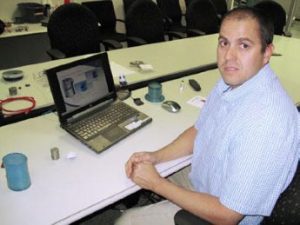Simulation of Rubber Products is a Growing Industry
News | February 11, 2014

RPN PHOTO BY BRUCE MEYER
Tony Johnson is a senior tooling engineer for mold making at Quadra Tooling & Automation, a unit of Q Holding Co. He uses finite element analysis to aid the firm in tooling and product development.
NORTH CANTON, Ohio—Giving proper simulation of rubber product processing remains difficult, but there has been much improvement in recent years, and its usage is increasing.
“The difficulty in simulating rubber is it is a non-linear simulation,” said Tony Johnson, senior tooling engineer for mold making at Quadra Tooling & Automation, a unit of Q Holding Co.
He is responsible for the mold design department at Quadra’s facility in North Canton, and he also assists in product design, working regularly with finite element analysis programs.
Some of the software from Ansys Inc. is among the better of the higher-end, non-linear software available on the market, according to Johnson.
The process can help both its customers and its internal operations. Quadra supports the efforts of the Quality Synthetic Rubber and Qure Medical operations that also are under the Q Holding umbrella.
“We assist the customers with their development and troubleshooting,” he said. “We get involved both at the beginning and down the road.”
Solving stress woes
Internally, it can help staff predict where high stresses will be during the molding process. When used properly, it can help Quadra reduce tooling costs, so the firm doesn’t have to design tooling more than once.
He told of how a customer who bought a plunger tip was seeing tears in the product. But after Quadra performed an FEA test on the tip, it showed where the stresses were and where the product was being torn. That led to a design change that reduced the stresses considerably and eliminated the tearing.
Another customer was having problems with an auto connector seal, where there had to be uniform contact at each point, and the holes needed to be in perfect alignment.
Johnson said the first step was to look at the product as it was formerly designed. “What I found was a problem that showed why they got high forces,” he said. “We went 14 iterations on this until the final version that we supplied to them. We increased the sealing pressures, reduced the internal stresses and reduced the insertion forces.”
It’s normal to do about 10-15 simulations per project, according to John Miller, Qure Medical technical support manager. “You usually improve after two, but you really don’t know unless you do a pretty wide range to find out how far you can go,” he said.
One key is to make sure that any materials data being input for the testing gives the proper information.
“Junk in equals junk out,” Johnson said. “If you have bad material data, it means you’re going to get bad results. If we don’t have the material data, I’ll use something I know works. Once the customer decides they want to go further, then we will test the exact material.”
There has been an increase in the use of FEA tooling, and that in turn helps make the development process more efficient, said Randy Ross, Q Holding president and CEO.
“Everybody focuses on the production process, but the development process has a lot of low hanging fruit, with multiple iterations and trial and error,” he said. “It’s something we’ve seen in automotive become almost second nature.
“In medical devices, it seems to be having increased utilization. It goes back to the idea that cost matters, and time to market matters. It puts a little more pressure on making development as efficient as the production process.”
Helping hand
Company officials said about 10-20 percent of projects go through the simulation process. Miller said it’s all driven by technology.
“It’s when you get into a specialty product or a new design or a customer having an issue with a current design—that’s when we use the FEA technology,” he said.”
Quadra has run FEA tests for customers even when Q Holding firms had no expectation of securing any jobs out of it.
“We charged them, but we had the ability to do it, so we were just helping out their engineers,” something that can benefit the firm down the line, he said.
Ross said familiarity will build use of the process. “As more customers see the benefit one time, they ask us to run FEA,” he said.
Johnson said the rubber simulation programs are difficult to develop because the high amount of defamation with rubber makes it tough to simulate, but the tools are getting better.
“I don’t like giving someone a date, because it could look like the simplest simulation but then take five days,” he said. “Or it could look like the most difficult simulation and take me a day.”
Computational advances have made the process easier, he said. With the system Quadra has in place, it can run up to eight processes at a time. “Even if you go through 12-14 iterations, each one takes much less time than it did before.”
Copyright © 2014 Crain Communications Inc. All Rights Reserved.



